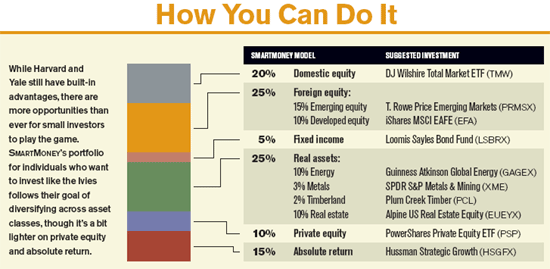Investopedia How To Invest Like An Endowment
Post on: 31 Май, 2015 No Comment

Research these Stocks on Kapitall’s Playground Now
By Manoj Singh, Investopedia: In addition to Harvard, Yale, Princeton and MIT, there are many other educational institutions that have been running a money machine in their own backyards. Contrary to popular impression, universities earn their living not just by teaching, but by running some of the most successful endowments in the world. Thats no surprise considering the fact that the top 20 endowments grew by more than 9% annually on a real basis between 1992 and 2005. However, with high negative returns in 2008, university endowments may have to devise new strategies something that Ivy Leagues always love to do. Read on to find out how Ivy Leagues manage their money through the thick and thin of economic cycles.
Behind Every Successful University, Theres a Successful Endowment
Lets first look at what a university endowment is. A university endowment is a fund created out of donations received by a university or college. Each university or college might have its own endowment, the size of which depends upon how much it is receiving in donations and how wisely it is using the existing corpus. Instead of spending the entire principal for current use, the universities invest it in order to generate income, part of which is withdrawn every year for meeting the Universitys expenses. Every year, university endowments on the average withdraw 4 to 5% of their asset value for current use. The National Association of College and University Business Officers (NACUBO), which conducts yearly surveys of college endowments, states in one of its studies that in 2008 endowment withdrawals constituted 15 to 20% on average of the colleges revenues .
Endowments follow two key objectives while making investments. First, they want to generate a high enough real return to take care of their yearly withdrawals without dipping into the principal. Second, the college wants to preserve the real value of its principal, which means that a part of the return is also used for augmenting the principal to take care of inflation. To be on the safer side, endowments use their own measurement of inflation the Higher Education Price Index (HEPI) that takes into account the prices of goods and services specific to higher education. It is believed that the HEPI generally exceeds the consumer price index for all urban consumers by 1%. In this manner, every university endowment tries to survive longer than its own creator.
The bigger endowments, like Yale and Harvard, have generated a return of 15.23% (Harvard) to 16.62% (Yale) between 1985 and 2008, when the S&P 500 was able to grow by about 12% on the average. You might be wondering how university endowments are actually able to beat the market. Is there any secret endowment formula that you too can use for investing?
Eating Your Cake with One Hand and Baking with the Other
University endowments know how to tell their own story. Every year they publish an annual report which tells us how much they have been allocating to each asset class. Although individual investments within each asset class are not known, we broadly know what kinds of assets endowments generally like. During the last two decades, between 1985 to 2008, the focus of bigger endowments (having asset size of US$1 billion and above) has been on a wide array of assets which include a small portion of traditional stocks and bonds and a large portion of non-traditional alternative assets in the form of hedge funds. private equity. venture capital and real assets like oil and natural resources.
Some of the investments chosen by endowments offer better returns than traditional stocks and bonds, but they typically have longer gestation periods requiring high minimum investment in a highly illiquid market. It is observed that for generating a high enough real return, endowments rely less on bonds or fixed-income securities and more on equity -type investments. Further, in equity type investments, the reliance is less on domestic equity and more on foreign equity. For instance, in 1988 nearly 75% of the Yale Endowment was committed to U.S. stocks, bonds and cash, but in 2008 it only had a 14% allocation in domestic market securities and an 86% allocation was made for foreign equity, private equity, absolute return strategies and real assets.
So, wherever there is an opportunity, you will find an endowment. But such kinds of investments suit bigger endowments that can lock in billions of dollars for longer periods in less efficient markets for exploiting profit opportunities. In choosing different asset classes, bigger endowments have the upper hand over smaller endowments that seem to be slow in exploiting profit opportunities in non-traditional asset classes.
Put Everything in Writing and Leave it to Others
Endowments dont blindly rush towards what may be coming their way. They strictly follow a well-documented investment policy decided by their investment committee, which is often compromised of imminent alumni of their own university. Investment committees generally lay down broad guidelines that are used for policy portfolio allocation. The portfolio allocation is focused on avoiding large losses and generating high enough real returns to take care of yearly withdrawals and inflation. Endowments have their own staff headed by a chief investment officer. However, for actual investment work, endowments generally hire outside investment managers .
Endowments also follow a well-documented spending policy that lays down broad guidelines for allocating endowment earnings for current use. In many cases, donors themselves specify the purpose for which the income generated from donated money could be used. Putting everything in writing brings discipline and focus for endowments, and it also serves as a learning opportunity for others .
Invest Like Endowments
If you want to go along with university endowments by emulating their investment strategy. then you might need to know a bit more about them. Before you start to seriously think about adopting any endowment-type strategy, just keep the following aspects in mind:
1. There has been a vast difference in the performance of different endowments. Some endowments, like Yale and Harvard, have consistently performed better than others. It is generally observed that larger endowments, having an asset size of more than US$1 billion, have outperformed smaller endowments. This may be because their investment strategy requires economies of scale .

2. Investment committees of university endowments play an important role in harnessing the broader knowledge base of the university for guiding endowment managers. The same level of guidance may not be available to individual investors.
3. Universities enjoy vast social networks which they successfully use for gaining access to many crucial investment opportunities .
4. Endowments are exempt from paying any taxes to the government. so they are free to make any investment decision without any tax consideration.
5. Endowments dont have the same liquidity needs as an individual investor, so they can lock their investments for longer time horizons .
6. Endowments with the best performances have earned higher returns by having a large exposure in alternative investments like hedge funds, private equities, venture capitals and real assets like timber forests etc. Allocation to alternative asset classes requires better asset selection skills, longer gestation periods and higher minimum investments, which every individual investor cant afford.
7. The two decades before the 2008 financial crisis were good for alternative assets. Endowments were pioneers in the alternative asset classes and they reaped high returns. But what has worked in the past may not work in the future. Now, endowments will have to devise new investment strategies .
8. The 2008 financial crisis didnt spare university endowments. All endowments together suffered estimated negative returns of 23% from July to November 2008, as per the NACUBO study. Many believe that it has been the worst drop since 1970s. It seems that even diversification into alternative assets cant provide complete protection against massive market declines.
The Bottom Line
Endowments have been successfully following their investment strategy for many years. A successful endowment helps in reducing the financial burden of a university by generating a consistent flow of income year after year. Although endowments disclose their investment policy and policy portfolio allocation among different asset classes, individual investors cant gain much by blindly following the same. After all, a successful formula is the one that cant be successfully imitated by others .














